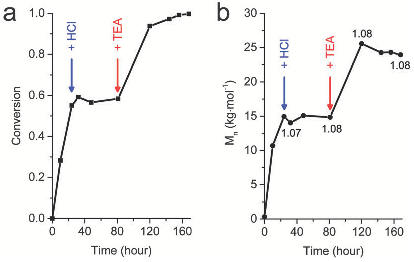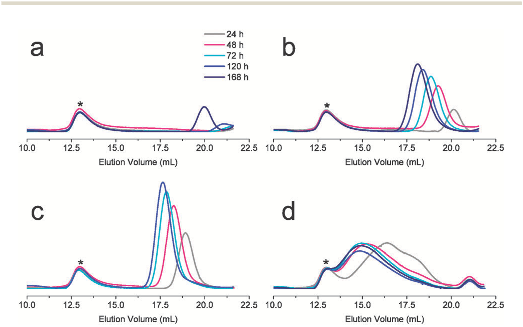Primary ammonium/tertiary amine-mediated controlled ring opening polymerisation of amino acid N-carboxyanhydrides.
TLDR
Stable commercial primary ammonium chlorides were combined with tertiary amines to initiate the controlled ring opening polymerisation of amino acid N-carboxyanhydrides to yield polypeptides with defined end group structure, predetermined molar mass and narrow molarmass distribution.About:
This article is published in Chemical Communications.The article was published on 2015-10-15 and is currently open access. It has received 43 citations till now. The article focuses on the topics: Tertiary amine & Molar mass distribution.read more
Figures

Fig. 4 Time-conversion plots for the polymerisations of (a) BLG–NCA (100 equiv.) and (b) LLeu–NCA (100 equiv.) in DMF initiated by BnA HCl (1 equiv.), BnA HCl/TEA (1 : 0.5 equiv.), BnA (1 equiv.), and TEA (0.5 equiv.). Monomer conversions were determined by FT-IR spectroscopy (see ESI†); numbers in (a) are the polymer dispersities determined by SEC. 
Fig. 3 Polymerisation of BLG–NCA (150 equiv.) in DMF initiated by PyA HCl/TEA (1 : 0.5 equiv.), paused at 24 h by adding HCl and resumed at 81 h by adding TEA. (a) time-conversion plot, (b) number-average molar mass and dispersities (at 24 h, 81 h, 120 h, and 168 h) determined by SEC. 
Fig. 2 SEC traces (RI in black, UV340nm in purple) of polymerisations of BLG–NCA (150 equiv.) in DMF initiated by (a) PyA HCl/TEA (1 : 1.1) at (top to bottom) 2 h, 6 h, 10 h, 24 h; (b) PyA HCl/TEA (1 : 1.5) at (top to bottom) 2 h, 6 h, 8 h, 24 h; the peak (*) is a high molar mass polystyrene (PS2M, 2 MDa) used as internal standard for calculating the monomer conversion (ESI†). 
Fig. 1 SEC traces of PBLGs obtained during the polymerisations of BLG–NCA (150 equiv.) in DMF initiated by (a) TAB 3HCl (1 equiv.), r.t.; (b) TAB 3HCl (1 equiv.), 50 1C; (c) TAB 3HCl/TEA (1 : 0.5 equiv.), r.t.; and (d) TEA (0.5 equiv.), r.t.; the peak (*) is a high molar mass polystyrene (PS2M; 2 MDa) used as internal standard for calculating the monomer conversion (ESI†).
Citations
More filters
Journal ArticleDOI
Physical Gelation of α-Helical Copolypeptides.
TL;DR: The study revealed that both copolypeptide composition and chain length affected secondary structure, gelation temperature, and gel stiffness.
Journal ArticleDOI
Targeted delivery of a guanidine-pendant Pt(IV)-backboned poly-prodrug by an anisamide-functionalized polypeptide
TL;DR: The anisamide group, a high affinity ligand recognizing the sigma (σ) receptors that are overexpressed on many human malignancies including prostate cancer, is incorporated at the surface of the Tg-PIC for active targeting and efficient internalization.
Journal ArticleDOI
Water-assisted and protein-initiated fast and controlled ring-opening polymerization of proline N-carboxyanhydride
Ya Ping Hu,Zi-You Tian,Wei Xiong,Dedao Wang,Ruichi Zhao,Yuan Xie,Yuqin Song,Jun Zhu,Huali Lu +8 more
TL;DR: The unexpected water-assisted controlled ROP of ProNCA is reported, which affords well-defined PLP as polyproline II helices in 2–5 minutes and almost-quantitative yields, providing a simple solution to a long-standing problem in PLP synthesis, and offers valuable guidance for the development of water-resistant Rop of other proline-like NCAs.
Journal ArticleDOI
Hyperbranched polylysine: Synthesis, mechanism and preparation for NIR-absorbing gold nanoparticles
TL;DR: The ring-opening polymerization (ROP) of N-(tetrafluoroboran ammonium)- l -lysine-N-carboxyanhydride (NH3BF4-Lys NCA) was initiated by triethylamine to prepare hyperbranched polylysine (HPlys) fluoroborate with narrow polydispersity at a low temperature as discussed by the authors.
Journal ArticleDOI
pH/redox-responsive core cross-linked based prodrug micelle for enhancing micellar stability and controlling delivery of chemo drugs: An effective combination drug delivery platform for cancer therapy.
Hailemichael Tegenu Gebrie,Kefyalew Dagnew Addisu,Haile Fentahun Darge,Yihenew Simegniew Birhan,Darieo Thankachan,Hsieh-Chih Tsai,Szu Yuan Wu +6 more
TL;DR: In this paper , the DOX-conjugated pH-sensitive polymeric prodrug Methoxy Poly (ethylene oxide)-b-Poly (Aspartate-Hydrazide) (mPEG-P [Asp-(Hyd-DOX)] was created using ring-opening polymerization.
References
More filters
Journal ArticleDOI
Emerging applications of stimuli-responsive polymer materials
Martien A. Cohen Stuart,Wilhelm T. S. Huck,Jan Genzer,Marcus Müller,Christopher K. Ober,Manfred Stamm,Gleb B. Sukhorukov,Igal Szleifer,Vladimir V. Tsukruk,Marek W. Urban,Françoise M. Winnik,Stefan Zauscher,Igor Luzinov,Sergiy Minko +13 more
TL;DR: This work reviews recent advances and challenges in the developments towards applications of stimuli-responsive polymeric materials that are self-assembled from nanostructured building blocks and provides a critical outline of emerging developments.
Journal ArticleDOI
Nanoparticle Polymer Composites: Where Two Small Worlds Meet
TL;DR: A challenge for future studies is to create hierarchically structured composites in which each sublayer contributes a distinct function to yield a mechanically integrated, multifunctional material.
Journal ArticleDOI
Facile synthesis of block copolypeptides of defined architecture
TL;DR: A polymerization strategy that overcomes difficulties by using organonickel initiators which suppress chain-transfer and termination side reactions is described, which allows the facile synthesis of block copolypeptides with well-defined sequences, which might provide new peptide-based biomaterials with potential applications in tissue engineering, drug delivery and biomimetic composite formation.
Journal ArticleDOI
Polypeptides and 100 years of chemistry of alpha-amino acid N-carboxyanhydrides.
TL;DR: This review summarizes the literature after 1985 and reports on new aspects of the polymerization processes, such as the formation of cyclic polypeptides or novel organometal catalysts and the role of NCAs in molecular evolution on the prebiotic Earth is discussed.
Journal ArticleDOI
Synthetic polypeptides for biomedical applications
TL;DR: This article summarizes recent developments in the synthesis of copolypeptides from polymerization of α-amino acid-N-carboxyanhydrides (NCAs), focusing on their development for potential use in biomedical applications.
Related Papers (5)
Synthesis of nearly monodisperse polystyrene-polypeptide block copolymers via polymerisation of N-carboxyanhydrides.
Ivaylo Dimitrov,Helmut Schlaad +1 more